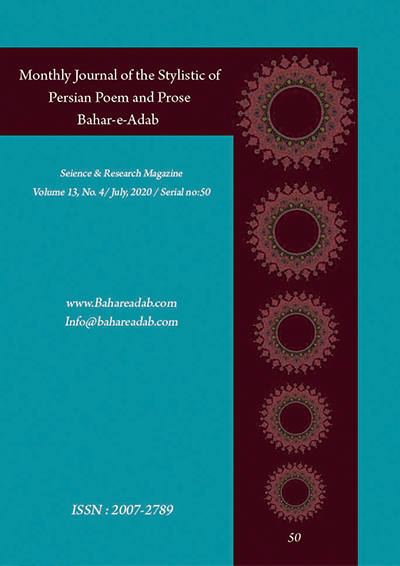- Count View : 581
- آدرس کوتاه شده مقاله: https://bahareadab.com/article_id/367
Journal of the stylistic of Persian poem and prose
volume Number 13،
number In Volume 4،
،
issue Number 50
The Role of Eloquence in Bidel and Kalim's Humorous Poems
Sadraghaed Ali, Hamid Tabasi(Author in Charge), Abolqasem Radfar
Abstract
Investigation of satirical poems of Indian style poets can provide insights into a new history that is different from that covered in the historical books. This history offers a detailed description of a nation that lived in Iran during the 11th and 12th centuries AH and covers social, ethical, cultural, religious and other aspects of their lives. In other words, the Indian style gives an account of the history of unrests, turmoil and cruelties that have, unlike pure history that is never repeated, been plaguing human societies over the course of history. In their satirical poetry, Indian style poets draw on literary-artistic language and mysterious rhetoric styles to address the reflective and wise people. In the present descriptive-analytical study attempts are made to investigate the influence of rhetorical techniques on the satirical poems of two famous Indian style poets namely Bidel Dehlavi and Kalim Kashani. To this end, the satirical poems of these two poets were studied and their rhetorical elements were identified. According to the results, Allegorical satire which is characterized by significant number of rhetorical elements account for the bulk of satirical language in their poetry. In the present article attempts are made to figure out which rhetorical elements play the most significant role in Bidel and Kalim"s satirical style.
Keyword
satire
, rhetoric
, Indian style
, Bidel
, Kalim
- Arianpour, Yahya (2008), From Saba to Nima, Tehran Zavar
- Zarrinkoob, Abdolhossein (2008), from Rendan Alley, Amirkabir, Tehran
- Razi, Shams Qais (1981), Dictionary in the criteria of non-popular poems, edited by Modarres Razavi, Tehran:zavar
- Rastegar Fasaei, Mansour (2010), Types of Persian prose, Tehran Samat
- Vahidian Kamyar, Taghi (2011), Innovative from the point of view of aesthetics, Tehran Samat
- Javadi, Hassan (2005), History of Humor in Persian Literature, Tehran Caravan
- Azhand, Yaghoub (2006), Literary Modernity in the Constitutional Period, Tehran, Research Institute
- Khorramshahi, Bahauddin (2001), Hafeznameh, Tehran Soroush
- Critchley, Simon (2005), on humor, translated by Soheil Sami, Tehran:Qoghnos
- Mousavi Garmaroodi, Seyed Ali (2001), Dagarkhand (A Short Introduction to Humor, Humor and Satire in Contemporary History), Tehran, Institute of Studies
- Bidel Dehlavi, Abdolqader (2010), Poetry Divan, edited by Khan Mohammad Khasteh and Khalilullah Khalili, Tehran Talaieh
- Kaleem Kashani, Aboutaleb (1375), Poetry Divan, edited by Mohammad Ghahreman, Mashhad, Quds Razavi Province
- Shafiee Kadkani, Mohammad Reza (2006), Poet of Mirrors, Tehran Agah
- Shafiee Kadkani, Mohammad Reza (2005), Imagination in Persian Poetry, Tehran Agah
- Pollard, Arthur (2002), humor, translated by Saeed Saeedpour, Tehran, Markaz
- Behzadi, Hossein (1999), Today's Iranian Comedians from the Beginning to the End of the Qajar Period, Tehran Dastan
- Radfar, A. (1995), What is humor and who is a satirist ?, Ghandparsi Magazine, No. 7, p. 150
- Kazeruni, A. (2010), Humor of Persian Literature and Its Types, Bahar Adab Quarterly, No. 4, p. 99
- Fesharaki, Mohammad (2010), New Critique, Tehran. Side
- Radfar, A. (1373), The Art of Humor and Its Realm, Persian Sugar Magazine, No. 6, p. 70

